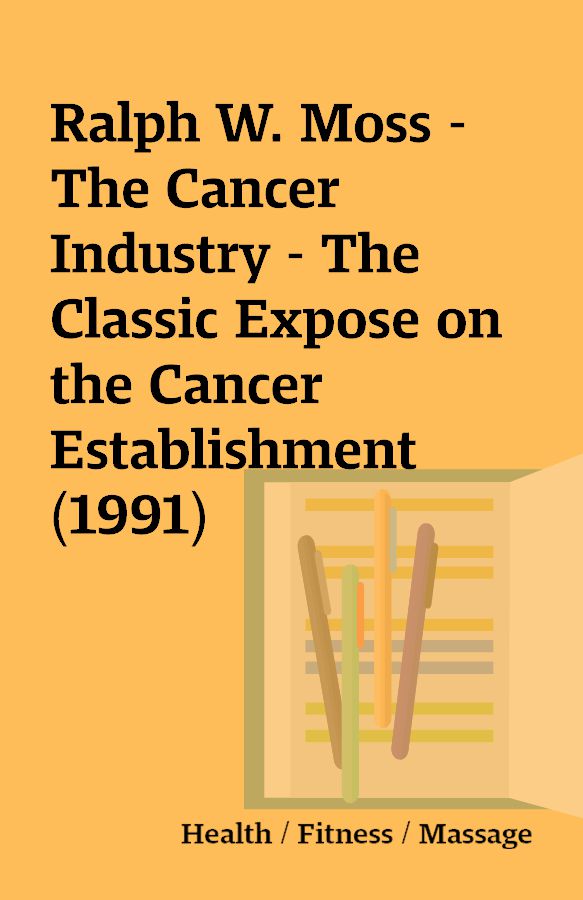Ralph W. Moss – The Cancer Industry – The Classic Expose on the Cancer Establishment (1991)
Ralph W. Moss – The Cancer Industry – The Classic Expose on the Cancer Establishment (1991)
[1 Scan – 543 JPG]
Description
http://www.amazon.com/Cancer-Industry-Ralph-W-Moss/dp/1881025098This gripping and controversial classic exposes the political and economic forces inside the cancer establishment.From Publishers WeeklyCiting static survival rates, the medical establishment’s support of “proven cures” including chemotherapy and its refusal to fund research into other therapies, Moss reveals that the medical establishment favors drug companies, carcinogen-causing and pollution-causing industries rather than potential and actual patients. PW called this a “tough-minded updated version of his 1980 The Cancer Syndrome .”4.0 out of 5 stars BEWARE THE MEDICAL-INDUSTRIAL COMPLEX October 3, 2005By Theresa WelshThe “war on cancer” is being lost and this book gives the primary reasons why. The current treatments – mainly chemotherapy and radiation – are largely ineffective and so toxic people often die from their treatment rather than their disease. There’s been nothing new from the research community in decades, and the number of cancer victims keeps rising. Ralph W. Moss worked at one of the most prestigious cancer research and treatment facilities in the US – Memorial Sloan-Kettering in New York. He quit when that institution deliberately misled the press and public about test results for a promising treatment. That treatment was the much-maligned laetrile (vitamin B-17) that was finally banned by the FDA and its proponents forced underground. Interestingly, Moss reports that Sloan-Kettering’s most respected researcher, Kanematsu Sugiura, stood by the efficacy of laetrile until his death.In The Cancer Industry, Moss shows how institutions like Sloan-Kettering pick and choose what to test and how to test it, and operate with a bias toward those methods that are the favorites of their financial backers, even to the point of disregarding their own researchers, as they did with Dr. Sugiura. The medical staff at Sloan-Kettering had a bias toward chemotherapy, since their Board of Directors included corporate bigwigs whose business interests benefited from chemo profits, which are enormous.Another promising treatment, hydrazine sulfate, suffered the same fate as laetrile, even though its backers had considerable success with it. Unlike chemo, which generally makes the patient sicker, hydrazine sulfate works by building the patient’s strength. It was the result of a logical deduction, arising from the fact that cancer patients often die of “cachexia,” a term that literally means “wasting away.” Hydrazine sulfate is an anti-cachexia agent. It works with the patient’s own resistance to restore health.What really doomed these two approaches to cancer treatment is that both are natural substances and their use in cancer treatment is part of a nutritional approach. Drug companies cannot patent anything natural or profit from nutritional therapy as they can from chemical substances which they alone control through patents. Laetrile is a naturally-occurring substance found in many foods, including apricots. Hydrazine sulfate is a very cheap substance that is readily available.Moss also examines in detail the treatment of William Coley (Coley’s Toxin) Dr. Lawrence Burton, Dr. Stanislaw Burzynski, Linus Pauling and vitamin C, and Virginia Livingston with her germ theory. All of these people achieved some success, but their methods were rejected by the orthodox cancer establishment.Moss does not suggest that there is a formal conspiracy to suppress alternate treatments, but he does suggest that the organizations that control the direction of cancer treatment, whether government agencies, private companies, or research and treatment centers, have interlocking personnel and the agendas that matter are those that keep the funds flowing. He also shows that big egos and personal rivalries play a large part.The cancer establishment has consistently downplayed prevention and ignored evidence that environmental factors or poor nutrition can be a cause or contributing factor in cancer. The big money interests that support the large charities like the American Cancer Society are not likely to approve of programs that suggest their products contribute to cancer. Moss examines the controversy over asbestos as a case study and shows how little interest there was among government or charities to warn the public about known dangers. While the entrenched players in the cancer war do little to inform the public about how to avoid the disease, they go out of their way to scare people about the likelihood that they will develop some form of cancer in their lifetime. Scare tactics bring in donations.The book is well-researched and full of details (names, dates, test results), but I would have liked more information about the efficacy of screening tests, which is another big money-maker for the medical establishment. Is it really worthwhile to have mammograms and colonoscopies? Moss suggests that the “find it early” philosophy often makes no difference in the ultimate outcome. Given the high price and potential dangers of some of these screening tests, do they really serve the public or only the pocketbooks of those who provide the tests? It seems to me that screening tests are pushed on the public as a substitute for a cure, which these organizations have failed to provide, despite the billions of dollars they have spent since America declared a war on cancer more than 30 years ago.It also seems to me that money is the primary motivator in all things medical in the US. Moss does not say there is a conspiracy and repeats the old mantra that a cure for cancer “would be worth a fortune.” But wouldn’t a cure ruin a perfectly good business, the cancer business? Moss shows just how many vested interests are involved in cancer, and I doubt any of them want to lose their market.I’m betting that if we ever have a cure, or even better treatments, that the innovation needed will not come from the bloated and greedy US health care system, but rather from some country that has government-funded health care… somewhere where the incentives are for bringing down the costs by finding a cure for a deadly and expensive scourge. If you continue to believe the claptrap about America having the best medical research, then consider that it was two Australians who discovered that ulcers are caused, not by stress, but by bacteria and can be quickly and cheaply cured. What American drug company would have had the incentive to make such a discovery? Dr. Barry Marshall, one of the Australians whose persistence resulted in the breakthrough, was quoted as follows:”The idea of stress and things like that was just so entrenched nobody could really believe that it was bacteria. It had to come from some weird place like Perth, Western Australia because I think nobody else would have even considered it.”Precisely the point of this book.Please contribute back by OCRing and Spellcheck/Proofreading this book. I recommend ABBYY Finereader 11 (or similar) for doing this work in a relatively easy way. If you plan to do that please leave a comment here so the effort won’t be duplicated by others. Please upload back the final pdf. Thank you.Please note that the high quality scan images are posted here for a specific purpose – to make it easy to OCR/spellcheck the book and not spend 100 hours doing that from a crappy, lossy compressed pdfs that are sometimes posted here. So please don’t waste your time asking why this is not a pdf file. Instead please contribute a few hours of your time and OCR and proofread the posted book. Thank you.
You must be logged in to post a review.






Reviews
There are no reviews yet.